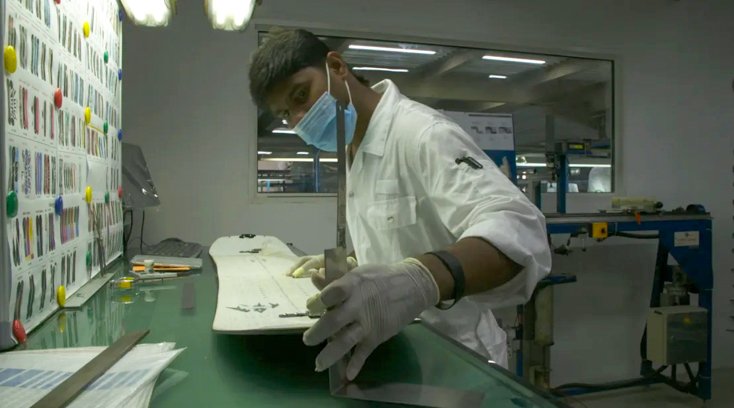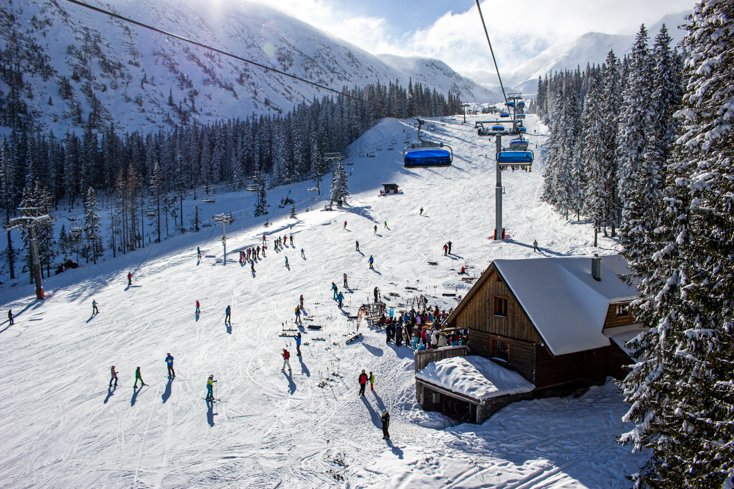Our passion for skiing is undeniable. Most of our lives revolve around it during the winter and it’s all we think about during the off-season. When we talk about our love of the sport, we also need to confront the impacts that such a massive industry has on the planet. Unfortunately, the ski industry can harm the environment, but in acknowledging these drawbacks, we can do a better job implementing solutions and mitigating some of the environmental harm that comes along with the industry.
Negative Environmental Impacts Of The Ski Industry
Even though we love skiing more than anything else on this planet, it would be false to say that it doesn’t come along with some negative impacts on the environment. Most of these are unavoidable, but we can do our part to lessen the damage that is associated with the industry.
Deforestation

Unless a ski resort is completely above treeline, trees need to be removed to create trails, buildings, parking lots, lifts, roads, and anything else that goes into creating a ski area.
Some of the benefits that trees provide within an ecosystem include,
- Air quality benefits
- Wildlife habitat
- Source of energy
- Water quality benefits
- Mental health benefits
This is far from all of the advantages that trees provide people and wildlife, but the key takeaway here is to remember that they are an extremely valuable natural resource.
Wildlife Habitat Destruction

Ski resorts are generally built in alpine areas, which are considered to be very fragile ecosystems when compared to lower-elevation areas. This is because resources such as food, water, and shelter are much harder to come by. That means even small disturbances to an alpine ecosystem can have more detrimental effects on the wildlife that call these areas home.
Infrastructure
Not only are ski resorts located in remote areas, they require large amounts of resources, like electricity, to operate. Snowmaking equipment, lifts, snowcats/plows, shuttle buses, lodges, and kitchens for the most part all run on fossil fuels. Every building needs to be heated and have running water, so you can imagine just how much work goes into getting these necessary resources to these remote areas.
Water Consumption

An almost mind-boggling amount of water is used in ski resort operations on a daily basis. This may come as a surprise to some because we rely on the snow that falls from the sky every season, but this doesn’t account for all of the water that is used on a daily basis.
Resorts rely on snow-making operations to open up earlier than other resorts in the area, and to ensure an even snowpack throughout the mountain. In theory, a resort will make more money the longer it’s open, but this comes at the cost of tapping into the local watershed.
Many resorts are located on or near national forest land and they siphon water from rivers and other bodies of water that are nearby. Much of the western United States has been in a drought for decades now, so this extra use of water only puts more stress on the watershed and ecosystem.
To put this in perspective, a single snowmaking machine can use over 100 gallons of water per minute. That equals 144,000 gallons of water every 24 hours. Multiply this by a couple dozen snowguns per resort and you end up with a major strain on the local water system.
Making The Ski Industry More Sustainable
Now this may all sound like doom and gloom, but there are plenty of things we can do to combat the impacts of the ski industry on the environment.
Renewable Energy

Sustainable energy sources are a promising way that we can keep up with the ever-growing demand for skiing and the infrastructure that goes along with it. We obviously can’t switch from fossil fuels to 100% renewable energy sources overnight, but if we start to integrate these technologies now, then we can lessen the negative impact that current fuel sources impose on the environment.
Let’s take a look at how much CO2 is produced in relation to some of the more popular energy sources that we use every day.
| Source Of Energy | C02 Produced per kWh |
| Wind | 11g-13g |
| Solar | 45g-54g |
| Natural Gas | 465g-475g |
| Coal | 975g-1,050g |
Transportation
As skiing gets more popular every year, highways and interstates become less and less effective at handling the excessive traffic that occurs during ski season. Public transportation such as busses, trains, and rideshares can help ease some of the burdens, but it is only a dent in the infrastructural nightmare that is weekend ski traffic.
Water Conservation
Their are tons of ways that resorts can implement water-saving measures that we see used in homes and businesses already, including low-flush toilets.
On a larger scale, snow-making technology has come a long way in the past few decades and resorts are opting to replace the old water-guzzling models with new high-efficiency snowguns.
Organizations That Support Sustainability
Skiing is an industry that is no stranger at attempting to reduce its harmful impact on the planet. There are countless organizations that support sustainability efforts – way too many to list here. Let’s take a look at a few big names in the sustainability sector of the ski industry.
Jones Snowboards Fair Trade Certification

Jeremy Jones is undoubtedly one of this generations snowboarding pioneers, especially when it comes to backcountry and big mountain riding. He founded Jones Snowboards with one thing in mind,
“To make the ultimate snowboarding gear that balances unmatched performance and durability with industry-leading sustainable manufacturing practices.”
And that’s exactly what he did. It’s no surprise that the entire line of 2024/2025 Jones snowboards and splitboards are all Fair Trade Certified. This award means that every step of the manufacturing process is done in a fair, ethical, and sustainable way. Everything from the harvesting for materials to the working conditions of the folks creating these top-of-the-line boards is something that Jeremy is definitely proud of, and if you ride Jones, then you should be just as proud for investing in a company that cares about keeping the planet in good enough shape so the next generation of shredders have snow to ride on.
mountainFLOW Eco-Wax

mountainFLOW Eco-Wax has been around since 2016 and they’ve been striving to create skiing products that are as eco-friendly as possible. Today they have pioneered a line of plan-based ski and snowboard waxes that aren’t hazardous to the environment and work just as well as the synthetic stuff. The line of products doesn’t stop there, they even offer a state-of-the-art infrared (IR) waxer that allows the bases of your skis/board to absorb more wax, generating less waste in the long run.
Protect Our Winters (POW)

If you know anything about skiing and the push for sustainability, then you have definitely heard of POW. Since 2007, these folks have helped give a voice to the outdoor sports community. Another one of Jeremy Jones projects, Protect Our Winters, is an organization that focuses on climate change and does everything in their power to make sure the sport of skiing doesn’t become a thing of the past. Everything from partnering with other environmental sustainability groups to lobbying for more eco-friendly practices in our daily lives, POW is at the forefront of making sure that someone is looking out for Mother Nature and everyone who loves to get outside and enjoy what she has to offer.
Want to learn more about Jeremy? Take a listen to this podcast conversation Jeremy Jones had with Mountain Weekly News Founder Mike Hardaker regarding sustainability in the ski industry and much more. Jeremy Jones talks the talk and actually walks the walk.. A true environmentalist first business owner second.
Final Thoughts
Although the ski industry can hurt the environment, there is a way for them to coexist. This symbiosis is attainable and is crucial for the longevity of the sport and our planet. There are measures we can take as individuals, and one of these efforts is supporting organizations that are conscious of the challenges we face with global environmental sustainability. By taking action now, we can ensure that skiing thrives well into the future for generations to come.
What are some steps you are taking to help solve this issues? Leave a comment below.
Related Articles:


I mostly agree with your points but I think that when it comes to water use you are missing part of the picture. It is true that snow making uses a huge amount of water, out in the west many resorts are limited in how much snow they can make based on water rights. What is important to remember though, is that once that water is used to make snow, it doesn’t just disappear forever. It sits there until spring and then melts, theoretically going back into the exact same water shed that it was pulled from. So in some instances snowmaking actually can serve to benefit drought prone areas by effectively creating a man-made glacier, storing water in the winter, when it is often in excess, that then goes into the water shed in the spring and summer months when it is often needed. There are of course, complexities and nuances that make every resorts impact unique. For example, if a resort is pulling water for snowmaking from an aquifer, it can take decades or even centuries before that water is replenished. However if a resort is using surface water such as from a reservoir or stream, then that water is just, in a sense, being held in place for a season before continuing on its merry way.
The same general sentiment could be applied to water that is treated and used as potable water. Such as water for drinking, cooking, cleaning, and flushing toilets. Many ski resorts have their own sewage treatment plants, or use those of a nearby municipality. Those that don’t use some sort of septic system with a drain field. In all of those cases that waste water is somehow eventually reintroduced into the local environment. The net net being that no water is truly wasted, it’s just made dirty and subsequently treated. The reality that people don’t like to think about is that most sewage treatment plants, whether it’s at a ski resort or in a city, reintroduce the treated effluent back into the surface water.